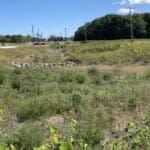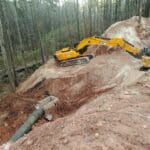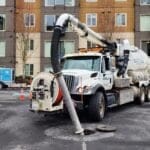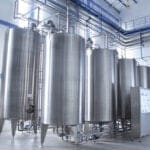Township of Lakewood
Lakewood Township has enacted Stormwater Ordinances in order to comply with state and federal regulations. Lakewood Township is the permitting authority for all land disturbing activities and requires the land owner to maintain all on-site stormwater control facilities and all open space areas (e.g. parks or “green” areas) required by the approved stormwater control plan. Lakewood Township will only provide construction permits to projects that establish a plan to manage stormwater runoff occurring during the construction process. Lakewood Township, under the NPDES program, also has the authority to inspect properties for noncompliance and can issue a notice of violation (NOV) for any deficiency or infraction onsite. Property owners are responsible for the maintenance of any stormwater facilities or practices located on the property. Lakewood Township has the authority to inspect stormwater facilities and practices in order to ascertain that they properly maintained and functioning.
Standards for Structural Stormwater Management Measures.
A. Standards for structural stormwater management measures are as follows:
1. Structural stormwater management measures shall be designed to take into account the existing site conditions, including, for example, environmentally critical areas, wetlands; flood-prone areas; slopes; depth to seasonal high water table; soil type, permeability and texture; drainage area and drainage patterns; and the presence of solution-prone carbonate rocks (limestone).
2. Structural stormwater management measures shall be designed to minimize maintenance, facilitate maintenance and repairs, and ensure proper functioning. Trash racks shall be installed at the intake to the outlet structure as appropriate, and shall have parallel bars with one-inch spacing between the bars to the elevation of the water quality design storm. For elevations higher than the water quality design storm, the parallel bars at the outlet structure shall be spaced no greater than one-third the width of the diameter of the orifice or one-third the width of the weir, with a minimum spacing between bars of one-inch and a maximum spacing between bars of six inches.
3. Structural stormwater management measures shall be designed, constructed, and installed to be strong, durable, and corrosion resistant.
4. At the intake to the outlet from the stormwater management basin, the orifice size shall be a minimum of two and one-half inches in diameter.
5. Stormwater management basins shall be designed to meet the minimum safety standards for stormwater management basins.
B. Stormwater management measure guidelines are available in the New Jersey Stormwater Best Management Practices Manual. Other stormwater management measures may be utilized provided the design engineer demonstrates that the proposed measure and its design will accomplish the required water quantity, groundwater recharge and water quality design and performance standards established by this ordinance.
Safety Standards for Stormwater Management Basins.
A. This section sets forth requirements to protect public safety through the proper design and operation of stormwater management basins. This section applies to any new stormwater management basin.
B. Requirements for Trash Racks, Overflow Grates and Escape Provisions.
1. A trash rack is a device designed to catch trash and debris and prevent the clogging of outlet structures. Trash racks shall be installed at the intake to the outlet from the stormwater management basin to ensure proper functioning of the basin outlets in accordance with the following:
a. The trash rack shall have parallel bars, with no greater than six inch spacing between the bars.
b. The trash rack shall be designed so as not to adversely affect the hydraulic performance of the outlet pipe or structure.
c. The average velocity of flow through a clean trash rack is not to exceed two and one-half feet per second under the full range of stage and discharge. Velocity is to be computed on the basis of the net area of opening through the rack.
d. The trash rack shall be constructed and installed to be rigid, durable, and corrosion resistant, and shall be designed to withstand a perpendicular live loading of three hundred (300) lbs/ft sq.
2. An overflow grate is designed to prevent obstruction of the overflow structure. If an outlet structure has an overflow grate, such grate shall meet the following requirements:
a. The overflow grate shall be secured to the outlet structure but removable for emergencies and maintenance.
b. The overflow grate spacing shall be no less than two inches across the smallest dimension.
c. The overflow grate shall be constructed and installed to be rigid, durable, and corrosion resistant, and shall be designed to withstand a perpendicular live loading of three hundred (300) lbs./ft sq.
3. For purposes of this paragraph 3, escape provisions means the permanent installation of ladders, steps, rungs, or other features that provide easily accessible means of egress from stormwater management basins. Stormwater management basins shall include escape provisions as follows:
a. If a stormwater management basin has an outlet structure, escape provisions shall be incorporated in or on the structure. With the prior approval of the reviewing agency a free-standing outlet structure may be exempted from this requirement.
b. Safety ledges shall be constructed on the slopes of all new stormwater management basins having a permanent pool of water deeper than two and one-half feet. Such safety ledges shall be comprised of two steps. Each step shall be four to six feet in width. One step shall be located approximately two and one-half feet below the permanent water surface, and the second step shall be located one to one and one-half feet above the permanent water surface.
c. In new stormwater management basins, the maximum interior slope for an earthen dam, embankment, or berm shall not be steeper than three horizontal to one vertical.
Maintenance and Repair.
B. General Maintenance.
1. The design engineer shall prepare a maintenance plan for the stormwater management measures incorporated into the design of a major development.
2. The maintenance plan shall contain specific preventative maintenance tasks and schedules; cost estimates, including estimated cost of sediment, debris, or trash removal; and the name, address, and telephone number of the person or persons responsible for preventative and corrective maintenance (including replacement). Maintenance guidelines for stormwater management measures are available in the New Jersey Stormwater Best Management Practices Manual. If the maintenance plan identifies a person other than the developer (for example, a public agency or homeowners’ association) as having the responsibility for maintenance, the plan shall include documentation of such person’s agreement to assume this responsibility, or of the developer’s obligation to dedicate a stormwater management facility to such person under an applicable ordinance or regulation.
3. Responsibility for maintenance shall not be assigned or transferred to the owner or tenant of an individual property in a residential development or project, unless such owner or tenant owns or leases the entire residential development or project.
4. If the person responsible for maintenance identified above is not a public agency, the maintenance plan and any future revisions shall be recorded upon the deed of record for each property on which the maintenance described in the maintenance plan must be undertaken.
5. Preventative and corrective maintenance shall be performed to maintain the function of the stormwater management measure, including repairs to or replacement of the structure; removal of sediment, debris, or trash; restoration of eroded areas; snow and ice removal; fence repair or replacement; restoration of vegetation; and repair or replacement of nonvegetated linings.
6. The person responsible for maintenance identified above shall maintain a detailed log of all preventative and corrective maintenance for the structural stormwater management measures incorporated into the design of the development, including a record of all inspections and copies of all maintenance-related work orders.
7. The person responsible for maintenance identified above shall evaluate the effectiveness of the maintenance plan at least once per year and adjust the plan and the deed as needed.
8. The person responsible for maintenance identified above shall retain and make available, upon request by any public entity with administrative, health, environmental, or safety authority over the site, the maintenance plan and the documentation required above.
9. The requirements of Sections 3 and 4 do not apply to stormwater management facilities that are dedicated to and accepted by the municipality or another governmental agency.
10. In the event that the stormwater management facility becomes a danger to public safety or public health, or if it is in need of maintenance or repair, the municipality shall so notify the responsible person in writing. Upon receipt of that notice, the responsible person shall have fourteen (14) days to effect maintenance and repair of the facility in a manner that is approved by the municipal engineer or his designee. The municipality, in its discretion, may extend the time allowed for effecting maintenance and repair for good cause. If the responsible person fails or refuses to perform such maintenance and repair, the municipality or County may immediately proceed to do so and shall bill the cost thereof to the responsible person.
Link
Lakewood Code of Ordinance
Lakewood Stormwater Website
 Kenosha, Wis. Highway KR Regenerative Stormwater ConveyanceThe Root-Pike Watershed Initiative Network Kenosha County, and others worked with AQUALIS to design and implement an innovative solution for stormwater control along Highway KR.
Kenosha, Wis. Highway KR Regenerative Stormwater ConveyanceThe Root-Pike Watershed Initiative Network Kenosha County, and others worked with AQUALIS to design and implement an innovative solution for stormwater control along Highway KR. Durham, N.C. Sinkhole Leads to Stormwater System RehabilitationThe tenant on this property noticed a depression that opened to the ground below and notified the property owners.
Durham, N.C. Sinkhole Leads to Stormwater System RehabilitationThe tenant on this property noticed a depression that opened to the ground below and notified the property owners.
